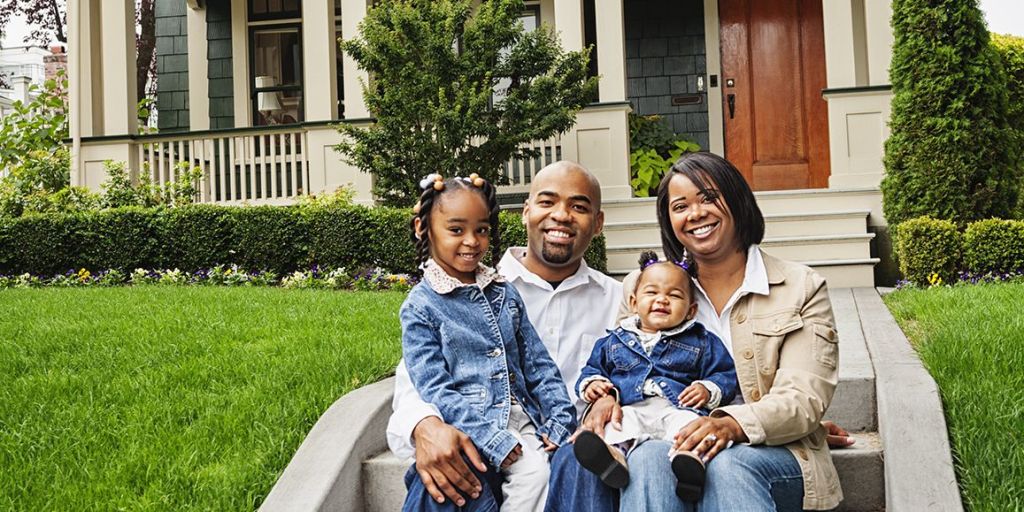Parroting the “YIMBY” narrative against single family homes encourages bad policies that hurt black and brown neighborhoods hardest



According to the L.A. Times editorial board, these people do not exist.
Occasionally the Los Angeles Times gets something so wrong that the resultant reporting or opinion is actually more enlightening than if they’d gotten it right. This morning the reliably bonkers Times editorial board swung for the fences on the issue of L.A.’s affordable housing crisis.
They lament that the City Planning Department has walked back plans to force dense multifamily new housing developments into existing single family neighborhoods. They despair that future multifamily development will be limited to a mere 28% of City land that is already zoned for such development. That number appears to come from a 2022 study entitled “Single-Family Zoning in Greater Los Angeles,” by researchers at something called the Othering & Belonging Institute at UC Berkeley (insert eye roll here). Like so much outcome-driven social science “research,” the authors made unsupportable assumptions and drew broad, generalized conclusions based on anecdote and supposition. They invented terms like “opportunity hoarding.” In short, it is not a serious piece of scholarship, but the Times editorial board accepts it as gospel.
As is often the case with what’s left of the once august paper, the editors get several points precisely backward. They write, for example, “Los Angeles needs a lot more housing but the current strategy fuels displacement and gentrification while leaving three-fourths of affluent residential areas untouched.”
Upzoning is gentrification
Note the sleight of hand. They equate “single family” with “affluent.” This ignores vast swaths of middle and working class single family neighborhoods like Sun Valley, Sunland-Tujunga, Pacoima, and San Fernando in the northeast valley, Van Nuys in the central valley, as well as Lincoln Heights, Boyle Heights, on the east side and West Adams, Leimert Park, South Park, South L.A., and Manchester. Exclusive, upscale communities like Pacific Palisades, Brentwood, Hancock Park, and Mulholland Ridge actually make up a small portion of the City’s single family stock.
In reality, the very policies the editors support are responsible for displacement at a mass scale, particularly in those working class areas. Apparently the editors missed their own reporters’ recent story about what’s happening to black and brown single family neighborhoods in Exposition Park and Jefferson Park. On March 20 reporters Doug Smith and Angie Orellana Hernandez actually committed an act of journalism. Their article was entitled “How student housing around USC is transforming a historic Black and Latino neighborhood.” It is a case study in how to blitzkrieg a close-knit, historic neighborhood with profitable apartment buildings.
The headline writer went easy. Saying the new USC student housing is “transforming” the neighborhood is like saying the Titanic had a “little mishap” on the way from Southampton to Manhattan. Over the last three years a venture capital backed Chinese developer called Tripalink has received city approval to demolish some 200 classic single family homes, many of which have passed through multiple generations. A lot of old shade trees will be collateral damage as quiet residential streets give way to hideously ugly three- and four-story “stack and pack” style student housing. Nor is the company any better at managing those ugly buildings once they’re finished and occupied: Tripalink has 120 Yelp reviews with an average of 1.5 stars. Common complaints include shoddy build quality, broken fixtures, leaks, stopped up sinks and toilets, broken door locks, and cockroaches and vermin.
So much for the views and western sunshine.
This is the L.A. Times’s brave new world of multi-family (in this case, multi-student) housing. Away with those wonderful, rambling, classic L.A. craftsman and Spanish style houses, be gone neighborhoods that have grown and flourished over generations, farewell generational wealth for thousands of black and brown families, for we have a brave new Utopia to build.
An assault on L.A.’s history
There’s another, particularly distressing aspect to the scenes unfolding in real time in South L.A. In 1945 Hattie McDaniel, the first black actress to win an Academy Award, for her role in Gone With The Wind, bought a single family home in Jefferson Park. The upscale neighborhood four miles from downtown had started losing residents as a result of the Great Depression and later when people moved farther west to up and coming zip codes like Beverly Hills, Beverly Crest, Holmby Hills, and Bel Air. Black Angelinos seized the opportunity, and Jefferson Park quickly became a core of black L.A. life and culture. McDaniel famously hosted lavish parties for black actors, entertainers, and artists, as well as for Hollywood’s A-list in general. Some Angelinos were scandalized by pictures in Hedda Hopper’s gossip columns of Clarke Gable dancing with McDaniels and Bert Williams cheek to cheek with Lauren Bacall. Duke Ellington, Count Basie, Cab Calloway, Ethel Waters, and others performed in McDaniel’s back yard. As more blacks bought homes they changed the neighborhood’s name to Sugar Hill, after an upscale section of Harlem.
At the time, the sales technically were illegal. Individual properties carried racially restrictive covenants on their deeds that forbade sales to non-whites and Jews. Contemporaneous real estate advertisements boasted that properties in the neighborhood were “restricted,” a feature they pitched alongside access to transit and large gardens.
In 1945 a group of white homeowners sued both the black buyers and the white sellers. McDaniel transformed her house from a center of art and culture to a giant war room. She organized weekly strategy meetings with some 250 supporters, as well as a pair of NAACP lawyers who represented the defendants in the case. The result was an extraordinary decision by the Los Angeles County Superior Court. Judge Thurmond Clarke dismissed the plaintiffs’ case, ruling that the restrictive covenants were unconstitutional. The ruling was exceptional in that state trial court judges rarely rule on constitutional issues on their own initiative. Judge Clarke wrote:
It is time that members of the Negro race are accorded, without reservations and evasions, the full rights guaranteed them under the 14th amendment of the Federal Constitution. Judges have been avoiding the real issue too long. Certainly there was no discrimination against the Negro race when it came to calling upon its members to die on the battlefields in defense of this country in the war just ended.
Judge Clarke penned those words less than three years after the end of World War II, and they hit home like a well-aimed 16-inch shell from the USS Texas taking out a Nazi pillbox on D-Day. It was the first time a judge used the 14th Amendment to “disallow the enforcement of covenant race restrictions,” according to the West Adams Heritage Association. Less than two years later the plaintiffs’ lead attorney, Loren Miller of the NAACP, subsequently used the same arguments before the U.S. Supreme Court in a case called Shelley v. Kraemer. Along with future Supreme Court Justice Thurgood Marshall, Miller persuaded the Court to declare racially restrictive covenants unconstitutional. The decision became a cornerstone of the growing Civil Rights Movement, and laid groundwork for subsequent decisions including Brown v. Board of Education. For a more in-depth history of Sugar Hill, check out this story.
Through the looking glass
Apparently the (overwhelmingly white) editorial board at the L.A. Times are blissfully unaware of these realities and history. Rather than focus on preserving, protecting, and enhancing historically non-white single family neighborhoods they believe the solution is to move people out altogether, to “higher resource” areas.
And there you see laid bare the soft racism that is at the core of the movement known as “Yes In My Backyard” (YIMBY) that is leading the assault on single family neighborhoods throughout California. Those poor black and brown folks cannot help themselves, they cannot create their own prosperity. They need benevolent politicians and bureaucrats and private developers to create “opportunity zones” and move those helpless souls into them. It’s paternalism at its most noxious. In many ways YIMBYism reads black and brown homeowners out of existence.
The Times editors got another important issue backwards. They wrote that the City’s 2021 housing plan “aims to comply with fair-housing law by putting affordable housing in high-opportunity communities, such as Encino, parts of Hollywood and the Westside, which have lots of jobs, good schools, transit stops, parks and other amenities. That would be a shift from historic patterns of segregation that concentrated affordable housing in lower-income, lower-resourced communities, such as South L.A. and the Northeast San Fernando Valley.”
Notice anything? They are calling for more investment in neighborhoods that already receive a disproportionate amount of it. Apparently they are content to let South L.A. and the northeast Valley languish with no new investment aside from upscale, unaffordable new apartment buildings, minimal job opportunities, poor schools, high crime, and transit deserts.
And that’s really the tell. California’s current YIMBY-fied approach to housing has nothing to do with increasing opportunities for historically underserved communities. That’s just the carnival barker pitch to kep the marks distracted.
In fact, over the last five years the legislature has passed and the Governor has signed more than 150 laws that for all practical purposes eliminate single family housing in the Golden State. No direct subsidies for affordable and workforce housing, even though direct subsidies are the only proven method to create such housing stock. No assistance for first time homebuyers. No investment in historically underserved communities. No reform in the monstrosity known as the Los Angeles Unified School District, which churns out tens of thousands of black and brown high school graduates every year who can barely read. None of the steps that would revitalize and rebuild actual neighborhoods in which actual people want to live. None of those long-term solutions. With apologies to the late John McCain it’s just “build, baby, build.”
Jefferson Park and Exposition Park are not alone. Developers are waging an all out assault on Leimert Park, long known as the heart of L.A.’s black arts and music. Crenshaw, another black single family community, is experiencing gentrification as a result of the misguided light rail extension. Similar displacement is occurring throughout working class and non-white neighborhoods from Pacoima to Wilmington.
At times the Times editorial is incoherent: “It also limits the availability of land for low-rise apartments, townhomes and bungalow courts that could soften the visual transition between single-family homes and 4- or 5-story apartment buildings on busy corridors, while filling a need in the middle-income housing market. These programs are the backbone of L.A’s housing plan.”
The “visual transition?” Have the Times’s editors seen the stack and packs that are springing up like poisonous mushrooms across the City and County? Developers and their monied investors do not give a fraction of a damn about aesthetics, much less neighborhoods. They are building as big and as fast and as cheaply as they can. Tripalink is not exceptional, it is typical.
Our failed political class in Sacramento allowed the housing affordability and homelessness crises fester for decades. Now, rather than desperately needed affordable housing subsidies and targeted neighborhood investments, they are punishing 40 million average Californians for their own neglect and incompetence. Shame on the Los Angeles Times for attempting to provide cover.
The good news is, hardly anyone reads the Times anymore.
